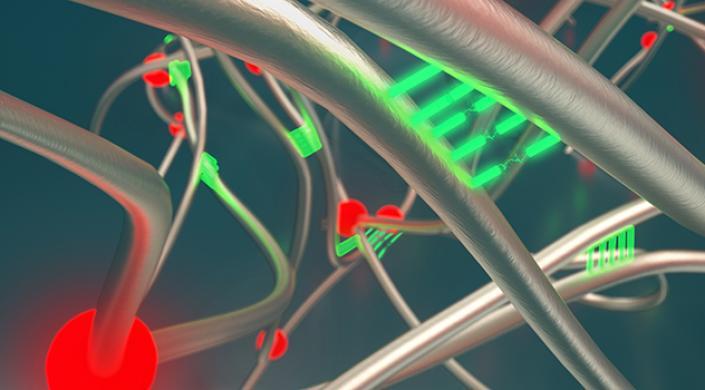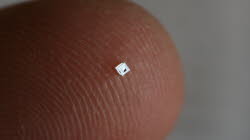Can accurately detect cancer-related molecules in blood and are small enough to be used in portable medical devices
A new method that fabricates gold nanostructures quickly and efficiently could lead to highly sensitive, portable medical sensors. Recent advances in nanotechnology are providing new possibilities for medical imaging and sensing. Gold nanostructures, for example, can enhance the fluorescence of marker dyes that are commonly used to detect biomolecules and diagnose specific diseases.
Now, Ping Bai at the A*STAR Institute of High Performance Computing, Singapore, and co-workers have developed a fast and inexpensive way to fabricate arrays of gold nanoholes. The researchers have shown that sensor chips built using these nanostructures can accurately detect cancer-related molecules in blood and are small enough to be used in portable medical devices.
Nanohole arrays are designed so that incident light of certain wavelengths will induce large-scale oscillations of the gold electrons, known as localized surface plasmon resonance (SPR). The localized SPR focuses the absorbed light energy to enhance fluorescence (see image).
“Commercial SPR systems are already used in hospital laboratories, but they are bulky and expensive,” says Bai. “We would like to develop small, handheld devices for on-the-spot clinical use. This requires localized SPR, for which we need nanohole arrays.”
Previously, nanohole arrays have been created using electron-beam lithography (EBL), which is expensive and time consuming. Bai and co-workers used EBL to create a nickel mold and then used the mold to print nanohole patterns onto a photoresist material. The researchers made the nanostructures by evaporating gold onto the patterned structure before peeling off the photoresist material. Because the nickel mold can be reused many times, this method — called nano-imprinting — can produce large numbers of gold nanohole arrays.
The Latest Bing News on:
Medical Sensors
- Researchers develop fluorescence-based sensor that measures oxygen content of breathon May 2, 2024 at 10:30 am
It's a novel method in medical engineering, though," says Dr. Benedikt Bierer, group manager at Fraunhofer IPM. Another advantage of this principle is that the sensor enables continuous measuring of ...
- Apple Watch AFib History Feature Qualified by FDA to Evaluate Medical Deviceson May 2, 2024 at 4:27 am
Apple's atrial fibrillation (AFib) history feature on Apple Watch has been qualified by the FDA under its Medical Device Development Tools ...
- Does Medicare cover medical alert systems? Here’s what experts want you to know about your optionson May 1, 2024 at 4:45 pm
Medical alert devices have come a long way since the 1980s Lifecall ads that featured an older woman on the ground saying, “I’ve fallen and I can’t get up.” Today’s medi ...
- Medical Sensors Market worth $3.6 billion by 2029 - Exclusive Report by MarketsandMarkets™on May 1, 2024 at 7:02 am
The medical sensors market is valued at USD 2.4 billion in 2024 and is projected to reach USD 3.6 billion by 2029; it is expected to grow at ...
- 'Smart' toilet seat monitors health data to proactively help patients in medical distresson April 30, 2024 at 8:30 pm
A smart toilet, similar to your smart watch, is capable of collecting vital data from your daily use of the toilet seat. This includes heart rate, blood pressure and temperature. The seat is being ...
- This Could Kill The iPhone Notch, Bring Cheap FaceID To Android, And Medical Apps To Your Cameraon April 30, 2024 at 12:03 pm
Phone has this face unlock feature, but it really hasn’t propagated outside of the iPhone because that module is very expensive, very complicated, and ..." ...
- Flexible Sensor Market to Reach $11.2 Billion Globally by 2032 at 7.7% CAGR: Allied Market Researchon April 30, 2024 at 2:55 am
The rising popularity of wearable devices and continuous technological advancements are projected to drive the global flexible sensor market's growth during the forecast period from 2032 to 2032. The ...
- Magnetoresistive Sensors Market Insights Anticipated US$ 371.5 Million by 2032, 4.3% CAGRon April 29, 2024 at 8:01 pm
The magnetoresistive sensors market is anticipated to grow at a CAGR of 4.3% in the global magnetoresistive sensors market throughout the projected period. Future market growth for magnetoresistive ...
- Wearable Sensors Market Outlook, Size, Prominent Players, Share, Revenue, and Forecast 2024 to 2032on April 28, 2024 at 3:09 pm
Report Ocean has recently unveiled its research findings on the “Wearable Sensors Market” spanning from 2024 to 2032. This comprehensive report thoroughly analyzes the market dynamics, including ...
- Brief Introduction to the Main Application Fields of Sensorson April 25, 2024 at 1:49 am
Sensors convert external signals into electrical signals and are used to monitor environmental parameters, detect the presence and position of objects, measure chemical composition and concentration, ...
The Latest Google Headlines on:
Medical Sensors
[google_news title=”” keyword=”Medical Sensors” num_posts=”10″ blurb_length=”0″ show_thumb=”left”]
The Latest Bing News on:
Nanotechnology
- Imec.xpand raises $320M for fund to invest in semiconductors and nanotechnologyon May 2, 2024 at 7:04 am
Imec.xpand, a chip and nanotech-focused venture capital fund, announced the launch of a new $320 million fund today.
- 3 Nanotech Stocks With the Potential to Make You an Overnight Millionaireon May 2, 2024 at 3:30 am
Investors should keep their eyes on the global nanotechnology market, which was valued at USD 3.78 billion in 2022 and is expected to reach USD 74.1 billion by 2032, growing at a CAGR of 34.5% during ...
- Vietnam Nanotechnology in Space Market Share, Growth Statistics, Size, Key Players, and Forecast to 2024 to 2032on May 2, 2024 at 12:00 am
According to the latest report by Report Ocean, titled this “Vietnam Nanotechnology in Space Market” Report gives evaluation and insights primarily based on authentic consultations with necessary ...
- Vietnam Aerospace Nanotechnology Market Outlook, Share, Top Players, Revenue, Size and Forecast to 2024 to 2032on May 1, 2024 at 11:30 pm
According to the latest report by Report Ocean, titled this “Vietnam Aerospace Nanotechnology Market” Report gives evaluation and insights primarily based on authentic consultations with necessary ...
- Nanotechnology opens door to future of insulin medicationon May 1, 2024 at 5:00 pm
(Nanowerk News) An international team, led by researchers from Australia, have developed a system using nanotechnology that could allow people with diabetes to take oral insulin in the future. The ...
- Ten things you should know about nanotechnologyon April 30, 2024 at 5:29 pm
By the way, we've devoted a Spotlight on this issue of perception of the nanoworld here: "Shaking hands with a virus - getting all touchy-feely with nanotechnology ". Often thrown together as ...
- NSF director Panchanathan, U.S. Sen. Young tout value of university-private sector partnerships to grow national, economic securityon April 29, 2024 at 9:52 am
“Purdue has a special connection with the National Science Foundation: from multiple Boilermakers leading the NSF in recent decades to a broad range of major NSF centers led by Purdue faculty,” said ...
- Nanotechnology in packaging: enhancing barrier properties and shelf lifeon April 29, 2024 at 4:29 am
Nanotechnology is revolutionising packaging materials, safeguarding products from spoilage and degradation while extending shelf life.
- Nanotechnology in Therapeuticson April 28, 2024 at 5:00 pm
Although progress in the application of nanotechnology to drug delivery has been dramatic and successful, as evidenced by some nanodrugs now on the market, several main challenges remain in this ...
- Engineering Powerful Vaccines with Lipid Nanotechnologyon April 21, 2024 at 6:15 am
In this, lipid nanoparticle (LNP) technology has emerged as highly promising. Progress in medical science has facilitated the seamless integration of lipid nanotechnology into standard therapy, ...
The Latest Google Headlines on:
Nanotechnology
[google_news title=”” keyword=”nanotechnology” num_posts=”10″ blurb_length=”0″ show_thumb=”left”]











